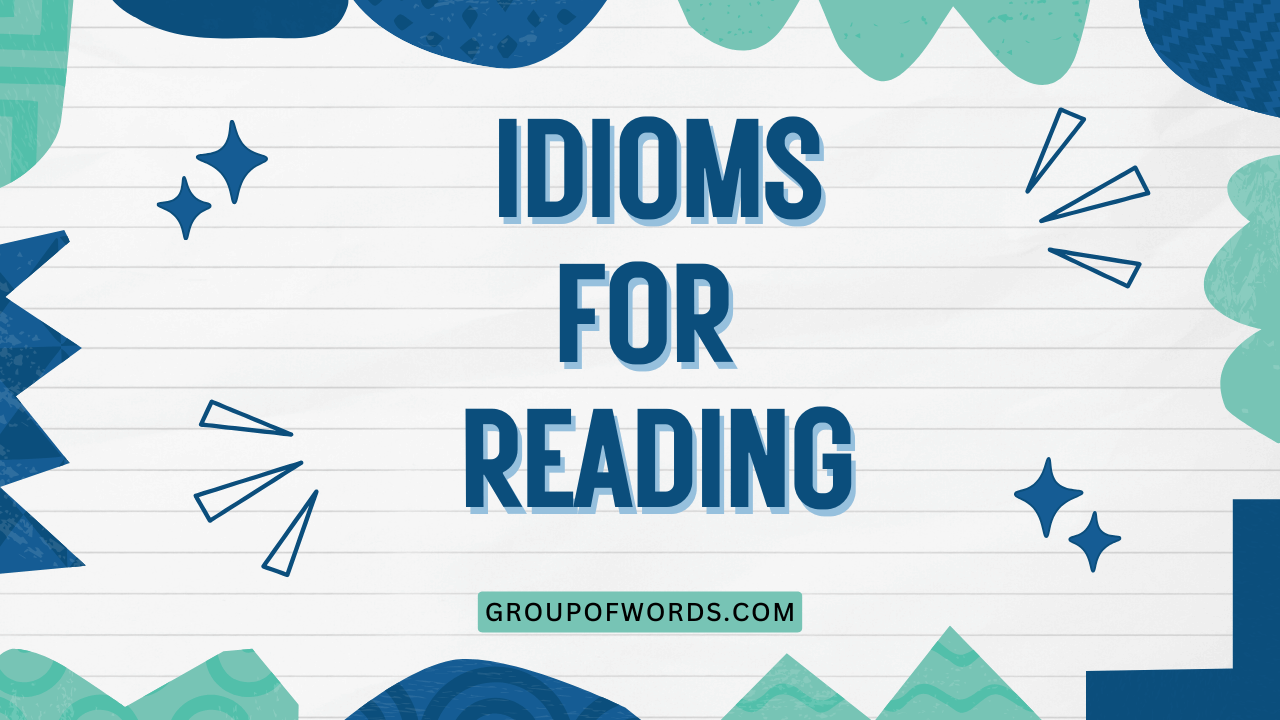Reading Between the Lines: Mastering Idioms for Reading
Idioms are an integral part of the English language, adding color, depth, and nuance to our communication. For English language learners, mastering idioms can significantly enhance comprehension, especially when encountering them in written texts.
This article focuses specifically on idioms related to reading, providing a comprehensive guide to understanding their meanings, usage, and common pitfalls. Whether you’re a beginner or an advanced learner, this resource will equip you with the knowledge and tools to confidently “read between the lines” and unlock the full potential of your reading experience.
Understanding idioms not only improves reading comprehension but also enhances your ability to communicate more effectively and naturally. It allows you to grasp the subtle layers of meaning in texts, appreciate the cultural context, and express yourself with greater precision and flair.
This article is designed to be a comprehensive guide, suitable for learners at all levels, from beginners to advanced. By the end of this article, you will be well-equipped to recognize, interpret, and even incorporate reading-related idioms into your own vocabulary.
Table of Contents
- Definition of Idioms for Reading
- Structural Breakdown of Reading Idioms
- Types and Categories of Reading Idioms
- Examples of Reading Idioms
- Usage Rules for Reading Idioms
- Common Mistakes with Reading Idioms
- Practice Exercises
- Advanced Topics in Reading Idioms
- Frequently Asked Questions
- Conclusion
Definition of Idioms for Reading
An idiom is a phrase or expression whose meaning cannot be understood from the literal meanings of its individual words. Instead, it has a figurative meaning that is known through common usage.
Idioms related to reading are those that use the act of reading, books, or related concepts to convey a different, often metaphorical, meaning. These idioms add richness and depth to the English language, allowing for more nuanced and colorful communication.
Idioms differ from literal expressions in that their meaning is not immediately apparent from the words themselves. For instance, the phrase “read between the lines” doesn’t literally mean to read in the space between lines of text.
Instead, it means to understand the hidden or implied meaning of something. The function of reading idioms is to provide a concise and evocative way to express complex ideas or feelings related to comprehension, interpretation, and knowledge acquisition.
They are frequently used in both spoken and written English, adding a layer of cultural understanding to communication.
The context in which an idiom is used is crucial for understanding its meaning. The same idiom can have slightly different connotations depending on the situation.
For example, “to be on the same page” can refer to agreeing on a plan, understanding a concept, or sharing a similar perspective. Understanding the context helps in correctly interpreting the intended meaning of the idiom.
By familiarizing yourself with common reading idioms and their contexts, you can significantly improve your comprehension of spoken and written English.
Structural Breakdown of Reading Idioms
Reading idioms, like all idioms, come in various structural forms. Understanding these structures can help in identifying and interpreting idioms more effectively.
Some common structural elements found in reading idioms include metaphors, similes, and metonymy. Each of these literary devices contributes to the unique and often non-literal meanings of the idioms.
Metaphors are a common structural element in idioms, creating an implicit comparison between two unlike things. For example, “to turn over a new leaf” uses the metaphor of a book’s page to represent making a fresh start in life. There is no literal turning of a leaf involved; it’s a symbolic representation. Similes, on the other hand, make an explicit comparison using words like “like” or “as.” While less common in reading idioms, they can still be found. Metonymy involves substituting a word or phrase for another with which it is closely associated. For example, “the pen is mightier than the sword” uses “pen” to represent writing and communication and “sword” to represent violence and warfare.
Many reading idioms also follow specific grammatical patterns. Some are simple phrases consisting of a verb and a noun, such as “hit the books.” Others are more complex, involving prepositional phrases or clauses.
Understanding these grammatical structures can help you recognize potential idioms and analyze their meanings. Furthermore, the word order in idioms is often fixed, meaning that changing the order of the words can alter or destroy the idiom’s meaning.
For example, “read between the lines” cannot be rearranged without losing its idiomatic sense.
Types and Categories of Reading Idioms
Reading idioms can be categorized based on their meanings and the aspects of reading they relate to. These categories can include comprehension, interpretation, knowledge, and the act of reading itself.
By understanding these categories, you can better grasp the nuances of each idiom and use them more effectively in your own communication. Some idioms are general, while others are more specific to academic or professional contexts.
Idioms Related to Comprehension
These idioms focus on understanding or failing to understand something.
Idioms Related to Interpretation
These idioms involve analyzing and explaining the meaning of something.
Idioms Related to Knowledge
These idioms concern the acquisition and possession of knowledge.
Idioms Related to the Act of Reading
These idioms describe the physical or mental process of reading.
Examples of Reading Idioms
The best way to understand reading idioms is to see them in context. The following tables provide numerous examples of reading idioms, along with their meanings and example sentences.
The tables are organized by the categories mentioned above, making it easier to find idioms related to specific aspects of reading. Each table includes a variety of idioms, ranging from common expressions to more obscure ones, providing a comprehensive overview of the topic.
Understanding how these idioms are used in sentences will help you incorporate them into your own vocabulary and communication.
Idioms Related to Comprehension
This table presents idioms that describe understanding or failing to understand something. Each idiom is accompanied by its meaning and an example sentence to illustrate its usage.
| Idiom | Meaning | Example Sentence |
|---|---|---|
| Read between the lines | Understand the hidden or implied meaning | The contract seemed straightforward, but you have to read between the lines to see the potential risks. |
| Get the gist | Understand the main point | I didn’t read the whole article, but I got the gist of it from the introduction. |
| Be on the same page | Have the same understanding or agreement | Before we start the project, we need to make sure everyone is on the same page. |
| Grasp the nettle | Deal decisively with a difficult issue | The company needed to grasp the nettle and address the declining sales figures head-on. |
| Miss the point | Fail to understand the important part of something | He completely missed the point of my argument. |
| Not have a clue | To have no understanding or knowledge about something. | I don’t have a clue what he’s talking about; it’s all jargon to me. |
| It’s all Greek to me | Completely incomprehensible | The technical manual is all Greek to me. |
| See the light | Finally understand something after a period of confusion | After hours of explanation, he finally saw the light and understood the concept. |
| Get your head around something | To understand something complicated. | I’m finding it difficult to get my head around this new software. |
| Draw a blank | Fail to remember something | I tried to remember her name, but I drew a blank. |
| Lose the thread | To lose the sequence of ideas in a discussion or explanation | I lost the thread of the argument halfway through his speech. |
| Make head or tail of something | Understand something | I can’t make head or tail of these instructions. |
| Click with someone | Understand and get along with someone immediately | I clicked with her as soon as we started talking about books. |
| Sink in | To be fully understood | The news about the job offer is finally starting to sink in. |
| Be crystal clear | To be very easy to understand. | The teacher made the instructions crystal clear. |
| A penny for your thoughts | A way of asking what someone is thinking about. | You seem lost in thought. A penny for your thoughts? |
| Wrap your head around | To understand something complicated or difficult. | It took me a while to wrap my head around quantum physics |
| Get the picture | Understand a situation | After his explanation, I finally got the picture. |
| Ring a bell | Sound familiar | That name rings a bell, but I can’t quite place him. |
| Under one’s belt | Having experience or knowledge. | With years of experience under her belt, she was the perfect candidate for the job. |
Idioms Related to Interpretation
This table presents idioms related to analyzing and explaining the meaning of something. Each idiom is accompanied by its meaning and an example sentence.
| Idiom | Meaning | Example Sentence |
|---|---|---|
| Take something with a grain of salt | Not to take something too seriously or literally | You should take his claims with a grain of salt; he tends to exaggerate. |
| Read too much into something | Interpret something beyond what is actually there | I think you’re reading too much into his comment; he probably didn’t mean anything by it. |
| Put two and two together | Draw an obvious conclusion | When I saw them together, I put two and two together and realized they were dating. |
| See something in black and white | See something as clearly defined, with no ambiguity | The contract sees everything in black and white, leaving no room for interpretation. |
| Read the room | Understand the mood or atmosphere of a situation | He didn’t read the room and told a joke that fell flat. |
| Between the devil and the deep blue sea | Between two equally difficult situations. | I was between the devil and the deep blue sea when I had to choose between betraying a friend and breaking the law. |
| Clear as mud | Not clear at all; confusing. | His explanation was as clear as mud. |
| Connect the dots | Understand something by relating different pieces of information. | The detective was able to connect the dots and solve the mystery. |
| Dig deeper | Investigate something more thoroughly. | The journalist decided to dig deeper into the corruption scandal. |
| Get to the bottom of something | Discover the truth about something. | I’m determined to get to the bottom of this mystery. |
| Look beyond the surface | Understand the deeper meaning of something. | We need to look beyond the surface and understand the underlying issues. |
| The writing on the wall | A sign that something bad is going to happen. | The company’s declining profits were the writing on the wall. |
| Take at face value | Accept something as it appears. | I took his apology at face value. |
| Tell apart | Distinguish between two things. | It’s difficult to tell the twins apart. |
| Behind the curtain | The secrets that are not obvious. | Let’s see what’s behind the curtain. |
| Give a clue | Help someone understand something. | Can you give me a clue? I’m completely lost. |
| Piece together | To assemble information to understand something. | The detective had to piece together the evidence to solve the crime. |
| Read into | Interpret or find a meaning in something. | Don’t read into his silence too much; he’s just tired. |
| Underlying message | The implicit meaning of a text. | The underlying message of the story is about the importance of friendship. |
| Take with a pinch of salt | To not completely believe something. | You should take his stories with a pinch of salt, as he tends to exaggerate. |
Idioms Related to Knowledge
This table features idioms concerning the acquisition and possession of knowledge. Each idiom is accompanied by its meaning and an example sentence.
| Idiom | Meaning | Example Sentence |
|---|---|---|
| Hit the books | Study hard | I have a big exam next week, so I need to hit the books. |
| Learn by heart | Memorize something | The actor had to learn his lines by heart. |
| Know something inside out | Know something very well | She knows this software inside out. |
| Brush up on something | Review or improve one’s knowledge of something | I need to brush up on my Spanish before my trip to Spain. |
| Pick up something | Learn something without formal study | I picked up a few phrases of Italian while traveling in Italy. |
| A walking encyclopedia | Someone who knows a lot of facts. | My grandfather is a walking encyclopedia; he knows something about everything. |
| Back to basics | Return to the fundamental principles of something. | The coach decided to take the team back to basics after a series of losses. |
| Crack a book | To open and study a book. | He never cracked a book during the entire semester. |
| Eager beaver | Someone who is very enthusiastic about learning. | She is an eager beaver when it comes to learning new languages. |
| Food for thought | Something to think about. | The speaker gave us some real food for thought. |
| In the know | Having inside information. | You should ask Sarah; she’s in the know about the project. |
| Keep abreast of | Stay up-to-date with the latest information. | It’s important to keep abreast of current events. |
| Learn the ropes | Learn how to do something. | It takes time to learn the ropes in a new job. |
| On top of | Having control of all the facts. | She is always on top of her work. |
| Quick study | Someone who learns quickly. | He’s a quick study; he picked up the new software in no time. |
| Well-read | Someone who has read a lot of books. | She is very well-read and can talk about any book. |
| Wise up | Become informed about something. | It’s time for him to wise up and understand the consequences of his actions. |
| At your fingertips | Easily available. | With the internet, information is at your fingertips. |
| Have your wits about you | Be alert and aware. | You need to have your wits about you when dealing with him. |
| Word of wisdom | Some good advice. | He gave me a word of wisdom that I will never forget. |
Idioms Related to the Act of Reading
This table presents idioms that describe the physical or mental process of reading. Each idiom is accompanied by its meaning and an example sentence.
| Idiom | Meaning | Example Sentence |
|---|---|---|
| Flick through | Look at a book or magazine quickly | I flicked through the magazine while waiting for my appointment. |
| Delve into | Explore or investigate something thoroughly | I decided to delve into the history of the region. |
| Skim through | Read something quickly, without paying attention to detail | I only had time to skim through the report before the meeting. |
| Devour a book | Read a book quickly and with great enthusiasm | She devoured the book in one sitting. |
| Get lost in a book | Become completely absorbed in a book | I love to get lost in a book on a rainy afternoon. |
| Turn the page | Start a new chapter or phase in life. | It’s time to turn the page and move on to a new beginning. |
| Dog-eared | Having the corners of the pages turned down. | The old book was dog-eared from years of use. |
| An open book | Someone easy to know. | She’s an open book. |
| By the book | Following the rules exactly. | He always does things by the book. |
| Close the book on | End something definitely. | It’s time to close the book on this project. |
| In the books | Possible. | Winning the lottery is technically in the books. |
| Read someone like a book | Understand someone’s thoughts and feelings easily. | She can read me like a book. |
| Take a leaf out of someone’s book | Follow someone’s example. | I should take a leaf out of her book and start exercising more. |
| Write off | Dismiss something as worthless. | Don’t write off his ideas just yet. |
| On paper | In theory, but not necessarily in practice. | The plan looks good on paper, but I’m not sure it will work in reality. |
| Story of my life | Expressing resignation to a familiar misfortune. | I missed the bus again. Story of my life. |
| Tell tales | Reveal secrets. | The walls could tell tales if they could talk. |
| Well-documented | Containing a lot of information. | The research is well-documented. |
| Written in stone | Impossible to change. | The decision is not written in stone. |
| Turn over a new leaf | Make a fresh start in life. | He decided to turn over a new leaf and quit smoking. |
Usage Rules for Reading Idioms
Using idioms correctly requires understanding their specific meanings and contexts. While idioms can add color and depth to your language, using them inappropriately can lead to confusion or miscommunication.
Therefore, it’s important to be aware of the usage rules that govern reading idioms. These rules include considering the audience, the formality of the situation, and the specific meaning of the idiom.
First, consider your audience. Some idioms are more commonly used in informal settings, while others are appropriate for formal communication. Using a casual idiom in a formal presentation, for example, might be inappropriate. Second, be mindful of the formality of the situation. In formal writing, it’s generally best to avoid idioms altogether, unless they are well-established and widely understood. In informal conversations or creative writing, idioms can be used more freely. Third, ensure you understand the specific meaning of the idiom. Using an idiom incorrectly can completely change the meaning of your sentence. Double-check the meaning of an idiom if you’re unsure, and consider using a more literal expression if you’re still uncertain.
There are also some exceptions to these rules. Some idioms have become so common that they are acceptable in both formal and informal settings. For example, “to be on the same page” is widely used in business and academic contexts. Additionally, some idioms have regional variations, meaning that their usage may differ depending on the part of the world. Be aware of these variations and adjust your language accordingly. By following these usage rules, you can use reading idioms effectively and appropriately, enhancing your communication skills and avoiding potential misunderstandings.
Common Mistakes with Reading Idioms
One of the most common mistakes with idioms is taking them literally. Because idioms have figurative meanings, interpreting them literally can lead to confusion and miscommunication.
For example, if someone says “hit the books,” they don’t mean to physically strike books; they mean to study hard. Another common mistake is using idioms out of context.
Each idiom has a specific context in which it is appropriate, and using it in a different context can change its meaning or make your speech sound awkward. It’s essential to understand the context in which an idiom is typically used before incorporating it into your own language.
Another frequent error is changing the wording of an idiom. Idioms are fixed expressions, and altering the words can destroy their idiomatic meaning.
For example, saying “read between the lines of the words” instead of “read between the lines” makes the expression sound unnatural and less effective. Additionally, some learners make the mistake of overusing idioms.
While idioms can add color to your language, using too many can make your speech sound unnatural or forced. Use idioms sparingly and only when they enhance your communication.
Here are some examples of common mistakes and their corrections:
| Incorrect | Correct | Explanation |
|---|---|---|
| I literally hit the books last night. | I hit the books hard last night. | “Hit the books” means to study hard, not to physically strike books. |
| We need to be on the same chapter. | We need to be on the same page. | The correct idiom is “on the same page,” not “on the same chapter.” |
| She knows the topic inside and outside. | She knows the topic inside out. | The correct idiom is “inside out,” not “inside and outside.” |
| He took his words with a grain of salt. | I took his words with a grain of salt. | The correct idiom refers to the speaker taking something with a grain of salt. |
| I am reading too much in it. | I am reading too much into it. | The correct idiom is “reading too much into it.” |
Practice Exercises
To solidify your understanding of reading idioms, try the following practice exercises. Each exercise focuses on different aspects of idiom usage, including identifying idioms, understanding their meanings, and using them in sentences.
The exercises range in difficulty, allowing you to challenge yourself and track your progress. By completing these exercises, you can reinforce your knowledge and improve your ability to recognize and use reading idioms effectively.
Exercise 1: Identifying Idioms
Identify the idiom in each sentence.
| Question | Answer |
|---|---|
| 1. I had to hit the books to pass the exam. | hit the books |
| 2. He always reads between the lines to understand the full story. | reads between the lines |
| 3. We need to make sure everyone is on the same page before we start. | on the same page |
| 4. The technical manual is all Greek to me. | all Greek to me |
| 5. She devoured the book in one sitting. | devoured |
| 6. It’s time to turn over a new leaf and start exercising. | turn over a new leaf |
| 7. He is always on top of his work. | on top of |
| 8. They had to go back to basics to improve their skills. | go back to basics |
| 9. She knows this subject inside out. | knows… inside out |
| 10. I lost the thread of the conversation. | lost the thread |
Exercise 2: Understanding Idiom Meanings
Match each idiom with its meaning.
| Idiom | Meaning |
|---|---|
| 1. Get the gist | a. Memorize something |
| 2. Learn by heart | b. Understand the main point |
| 3. Brush up on | c. Stay informed |
| 4. Keep abreast of | d. Dismiss as worthless |
| 5. Write off | e. Review or improve |
Answers: 1-b, 2-a, 3-e, 4-c, 5-d
Exercise 3: Using Idioms in Sentences
Complete each sentence with the appropriate idiom from the list: read the room, draw a blank, tell apart, connect the dots, food for thought.
| Question | Answer |
|---|---|
| 1. The speaker gave us some real __________. | food for thought |
| 2. I tried to remember his name, but I __________. | drew a blank |
| 3. She can always __________, understanding the mood of the situation. | read the room |
| 4. It took the detective a while to __________ and solve the case. | connect the dots |
| 5. It’s hard to __________ the twins; they look so alike. | tell apart |
Advanced Topics in Reading Idioms
For advanced learners, there are several more complex aspects of reading idioms to explore. These include the historical origins of idioms, their cultural significance, and their use in literature and rhetoric.
Understanding these advanced topics can provide a deeper appreciation of the richness and complexity of the English language. Exploring the etymology of idioms can reveal fascinating insights into their origins and evolution.
Many idioms have roots in historical events, cultural practices, or literary works. Understanding these origins can provide a deeper understanding of the idiom’s meaning and usage.
Additionally, idioms often carry cultural significance, reflecting the values, beliefs, and experiences of a particular community. Some idioms are specific to certain regions or social groups, while others are more widely understood.
Being aware of these cultural nuances can help you use idioms more appropriately and avoid potential misunderstandings. Furthermore, idioms are frequently used in literature and rhetoric to add emphasis, create imagery, and engage the reader.
Analyzing how idioms are used in different literary genres can provide valuable insights into their stylistic effects and rhetorical power.
Finally, advanced learners can also explore the use of idioms in translation. Translating idioms from one language to another can be challenging, as the literal translation often does not convey the intended meaning.
Understanding the cultural and linguistic context of idioms is crucial for accurate and effective translation. By delving into these advanced topics, you can further enhance your understanding of reading idioms and their role in the English language.
Frequently Asked Questions
Here are some frequently asked questions about reading idioms:
- What is the difference between an idiom and a metaphor?
An idiom is a phrase whose meaning is different from the literal meanings of its individual words and has become a fixed expression through common usage. A metaphor is a figure of speech that directly compares two unrelated things, highlighting their similarities. While some idioms may contain metaphors, not all metaphors are idioms. An idiom’s meaning is not derived from its literal interpretation, while a metaphor’s meaning is based on the comparative relationship it establishes.
- How can I improve my understanding of idioms?
The best way to improve your understanding of idioms is through exposure and practice. Read widely, listen to native speakers, and pay attention to how idioms are used in context. Keep a notebook of new idioms you encounter, along with their meanings and example sentences. Practice using idioms in your own speech and writing, and don’t be afraid to ask for feedback from native speakers.
- Are idioms the same in all English-speaking countries?
No, idioms can vary significantly between different English-speaking countries and regions. Some idioms are specific to certain areas, while others may have different meanings or connotations depending on the location. Be aware of these regional variations and adjust your language accordingly. For instance, an idiom common in British English might not be understood in American English, and vice versa.
- Is it okay to use idioms in formal writing?
In general, it’s best to avoid using idioms in formal writing, unless they are well-established and widely understood. Formal writing typically requires a more precise and literal style, and idioms can sometimes be ambiguous or informal. If you’re unsure whether an idiom is appropriate for a formal context, it’s best to use a more literal expression.
- What should I do if I don’t understand an idiom?
If you encounter an idiom you don’t understand, try to find its meaning in a dictionary or online resource. Pay attention to the context in which the idiom is used, as this can often provide clues to its meaning. If you’re still unsure, ask a native speaker to explain the idiom to you. Understanding the context and asking for clarification are key to deciphering unfamiliar idioms.
- How can I avoid misusing idioms?
To avoid misusing idioms, make sure you understand their specific meanings and contexts. Double-check the meaning of an idiom if you’re unsure, and consider using a more literal expression if you’re still uncertain. Pay attention to how idioms are used by native speakers, and avoid changing the wording of an idiom, as this can destroy its idiomatic meaning. Practice using idioms in your own speech and writing, and ask for feedback from native speakers.
- Are there any online resources for learning idioms?
Yes, there are many online resources for learning idioms. Some popular websites include The Free Dictionary, Merriam-Webster, and various English learning websites. These resources often provide definitions, examples, and quizzes to help you learn and practice idioms. Additionally, many language learning apps include lessons on idioms.
- How important is it to learn idioms for understanding native English speakers?
Learning idioms is crucial for understanding native English speakers. Idioms are an integral part of everyday conversation and written communication, and native speakers often use them without even realizing it. Without a good understanding of idioms, you may miss the subtle nuances of meaning and struggle to fully comprehend what native speakers are saying or writing.






